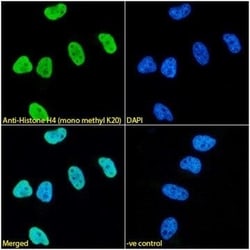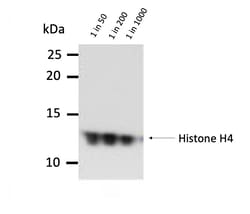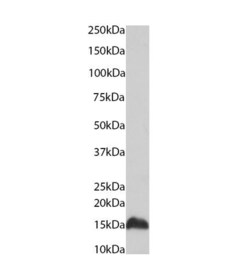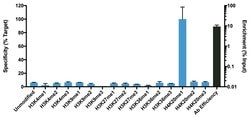Learn More
Invitrogen™ H4K20me1 Monoclonal Antibody (5E10-D8), ChIP-Verified


Mouse Monoclonal Antibody
$175.00 - $710.00
Specifications
| Antigen | H4K20me1 |
|---|---|
| Clone | 5E10-D8 |
| Concentration | 1 mg/mL |
| Content And Storage | Store at 4°C short term. For long term storage, store at -20°C, avoiding freeze/thaw cycles. |
| Applications | ChIP Assay, Dot Blot, ELISA, Flow Cytometry, Immunohistochemistry (Paraffin), Western Blot, Immunocytochemistry |
| Catalog Number | Mfr. No. | Quantity | Price | Quantity & Availability | |||||
|---|---|---|---|---|---|---|---|---|---|
| Catalog Number | Mfr. No. | Quantity | Price | Quantity & Availability | |||||
PIMA518067
 |
Invitrogen™
MA518067 |
100 μL |
Each for $710.00
|
|
|||||
|
PIA51806720
|
Invitrogen™
MA51806720UG |
20 μg |
Each for $175.00
|
|
|||||
Description
This antibody is specific for K20 mono-methylated histone H4 and does not cross-react with histone 3 or tri-, di-, or unmethylated histone H4. This antibody is predicted to react with Xenopus laevis, Arabidopsis thaliana, Fruit fly (Drosophila melanogast), and most mammals based on sequence homology. This target has a predicted molecular weight of 11 kDa. Actual Western blot results show a band at 13 kDa. This can be blocked using mono-methyl K20 Histone H4 peptide. Click here for Master Lot linking information.
Histones are basic nuclear proteins that are responsible for the nucleosome structure of the chromosomal fiber in eukaryotes. Two molecules of each of the four core histones (H2A, H2B, H3, and H4) form an octamer, around which approximately 146 bp of DNA is wrapped in repeating units, called nucleosomes. The linker histone, H1, interacts with linker DNA between nucleosomes and functions in the compaction of chromatin into higher order structures. This gene is intronless and encodes a member of the histone H4 family. Transcripts from this gene lack polyA tails but instead contain a palindromic termination element. This gene is found in the large histone gene cluster on chromosome 6.Specifications
| H4K20me1 | |
| 1 mg/mL | |
| ChIP Assay, Dot Blot, ELISA, Flow Cytometry, Immunohistochemistry (Paraffin), Western Blot, Immunocytochemistry | |
| Unconjugated | |
| Mouse | |
| RUO | |
| PBS with 0.1% sodium azide | |
| P62805 | |
| 121504, 8294, 8359, 8363, 8366, 8367, 8370 | |
| Synthetic peptide within Human Histone H4 (mono methyl K20)(Immunogen sequence: 15-AKRHR(Kme)VLRDN-25 (branched)). | |
| Antibody |
| 5E10-D8 | |
| Store at 4°C short term. For long term storage, store at -20°C, avoiding freeze/thaw cycles. | |
| Monoclonal | |
| Liquid | |
| IgG1 | |
| Human | |
| H4C1 | |
| BcDNA:RH52884; CELE_T10C6.11; CG31611; CG3379; CG3379-PA; CG3379-PB; CG3379-PC; CG3379-PD; CG33869; CG33871; CG33873; CG33875; CG33877; CG33879; CG33881; CG33883; CG33885; CG33887; CG33889; CG33891; CG33893; CG33895; CG33897; CG33899; CG33901; CG33903; CG33905; CG33907; CG33909; Dmel\CG3379; Dmel_CG3379; F07B7.11; F07B7.4; F45F2.12; FBtr0082962; FO108; H4; H4 clustered histone 11; H4 clustered histone 2; H4 histone family, member A; H4 histone family, member I; H4 histone family, member J; H4 histone family, member M; H4 histone family, member N; H4 histone, family 2; H4 K20; H4.1; H4/A; H4/B; H4/C; H4/D; H4/E; H4/G; H4/H; H4/I; H4/J; H4/K; H4/M; H4/N; H4/O; H4/p; H4-12; H4-16; H4-53; H4C1; H4C11; H4C12; H4C13; H4c14; H4C15; H4C2; H4c3; H4c4; H4C5; H4c6; H4c8; H4C9; H4f16; H4F2; H4FA; H4FB; H4FC; H4FD; H4FE; H4FG; H4FH; H4FI; H4FJ; H4FK; H4FM; H4FN; H4FO; H4K20; H4K20me; H4Lys20me; H4Lys20me1; H4M; H4r; his-20; his-22; His4; his-4; His4:CG31611; His4:CG33869; His4:CG33871; His4:CG33873; His4:CG33875; His4:CG33877; His4:CG33879; His4:CG33881; His4:CG33883; His4:CG33885; His4:CG33887; His4:CG33889; His4:CG33891; His4:CG33893; His4:CG33895; His4:CG33897; His4:CG33899; His4:CG33901; His4:CG33903; His4:CG33905; His4:CG33907; His4:CG33909; His4-88CD; His4r; His4r-PA; His4r-PB; His4r-PC; His4r-PD; his-52; his-54; his-8; HIST1H4; hist1h4a; hist1h4a.L; Hist1h4b; Hist1h4c; Hist1h4d; HIST1H4E; Hist1h4f; HIST1H4H; HIST1H4I; HIST1H4J; Hist1h4k; HIST1H4L; Hist1h4m; Hist2h4; HIST2H4A; HIST2H4B; HIST4H4; histone 1, H4a; histone 1, H4b; histone 1, H4e; histone 1, H4i; histone 1, H4l; histone 2, H4; histone 2, H4a; Histone 4; Histone 4 family, member M; histone 4, H4; histone cluster 1, H4a; histone cluster 1, H4a L homeolog; histone cluster 1, H4b; histone cluster 1, H4e; histone cluster 1, H4i; histone cluster 2, H4; histone cluster 2, H4a; Histone Cluster 4; histone cluster 4, H4; histone family member; Histone H2B 2; histone H3; histone H4; Histone H4 replacement; histone H4.1; Histone H4A; Histone H4K20me1; histone IV, family 2; K06C4.12; K06C4.4; LOC102161782; methyl Histone 3; methyl Histone H3; Methyl-H4 K20; Methyl-H4 Lys20; Methyl-Histone H4 K20; Methyl-Histone H4 Lys20; Mono-methyl H4; Mono-methyl Histone H4; RH52884p; T10C6.11; X04652; XELAEV_18001418mg | |
| H4-16, H4C1, H4C11, H4C14, H4C2, H4C5, H4C9 | |
| Primary | |
| Protein G |
Your input is important to us. Please complete this form to provide feedback related to the content on this product.



